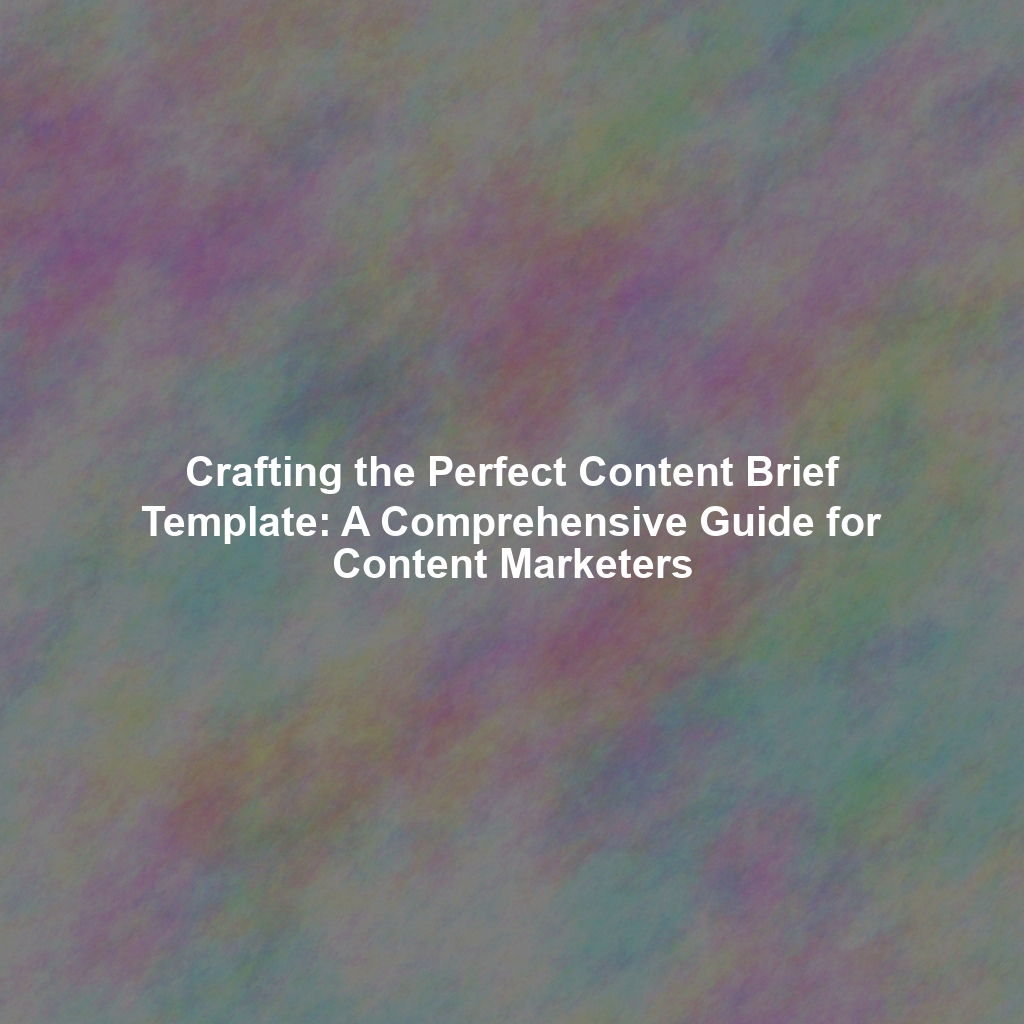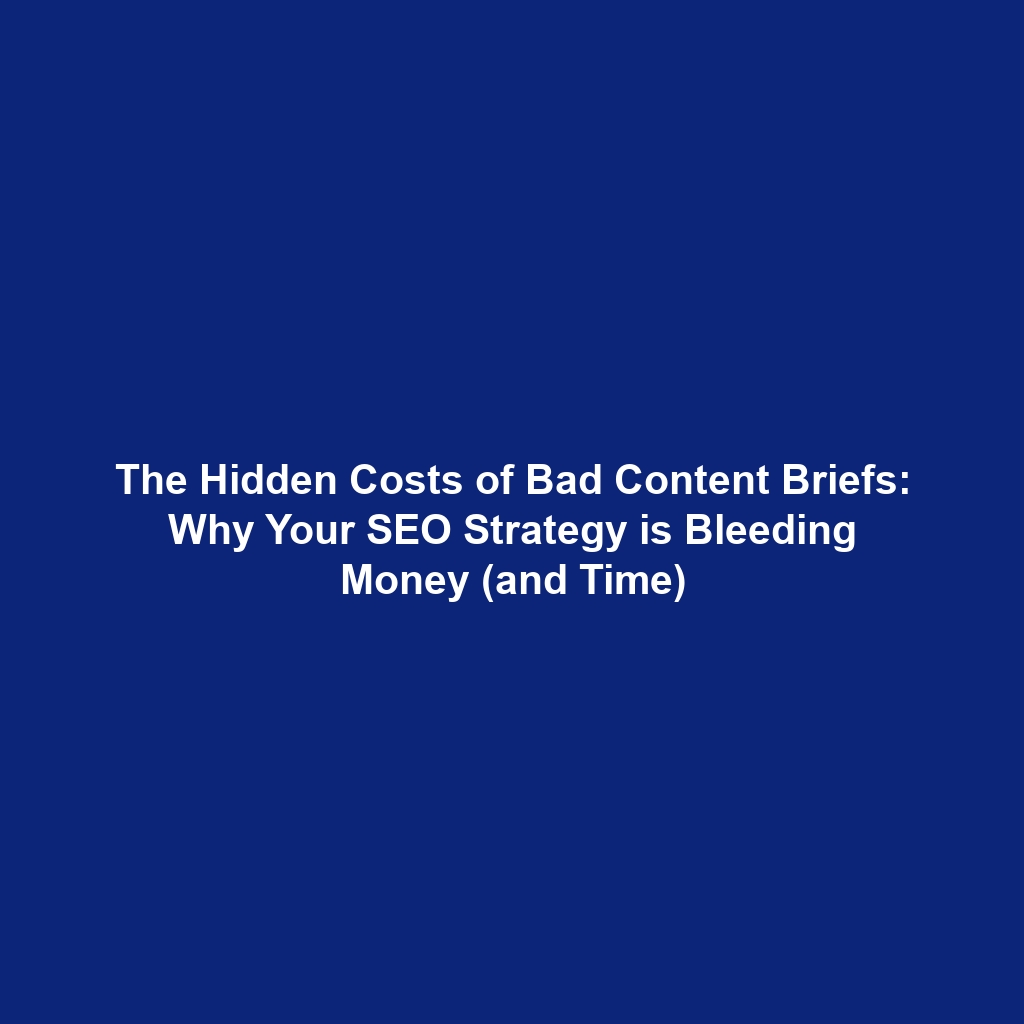Why Content Brief Templates are Essential for Content Marketing Success
In the fast-paced world of content marketing, consistency and quality are paramount. A well-structured content brief acts as a blueprint, ensuring everyone involved – from content strategists to writers and designers – is aligned on the goals, target audience, and key messages. Without a clear content brief, you risk creating content that misses the mark, wastes resources, and ultimately fails to achieve its intended objectives. This guide will walk you through creating a robust content brief template that will streamline your content creation process and elevate your content marketing strategy.
Understanding the Core Components of a High-Performing Content Brief Template
A comprehensive content brief template should cover all the essential elements required for a writer to produce effective and engaging content. Let’s break down the key components:
1. Project Overview and Goals
This section provides a high-level summary of the content piece and its purpose. It should answer the fundamental questions: Why are we creating this content? What problem does it solve? What do we hope to achieve?
Example:
Project Title: Ultimate Guide to Content Brief Templates
Project Goal: To attract content marketers, writers, and strategists to our website by providing a comprehensive and actionable guide on creating effective content briefs. We aim to increase organic traffic and generate leads by offering a valuable resource.
Business Goals: Increase website traffic by 20% within 3 months, generate 50 qualified leads.
2. Target Audience Definition
Clearly define who you are trying to reach. Include demographic information, psychographic details, pain points, and motivations. The more specific you are, the better the writer can tailor the content to resonate with the audience.
Example:
Target Audience: Content marketers, freelance writers, and content strategists working in B2B and B2C industries. These individuals are responsible for planning, creating, and managing content to drive engagement, generate leads, and increase brand awareness. They are seeking practical advice and actionable templates to improve their content creation workflow.
Pain Points: Struggling to create consistent, high-quality content; facing challenges in aligning writers with project goals; wasting time on revisions due to unclear instructions; difficulty measuring content effectiveness.
3. Topic and Keywords
Specify the main topic of the content piece and provide a list of primary and secondary keywords. This section is crucial for SEO optimization and ensuring the content ranks well in search engine results. Use keyword research tools like Ahrefs or Semrush to identify relevant keywords with high search volume and low competition.
Example:
Primary Keyword: Content brief template
Secondary Keywords: Content brief example, how to write a content brief, content marketing brief, SEO content brief, content creation brief, sample content brief, content brief guidelines.
Latent Semantic Indexing (LSI) Keywords: Content strategy, content planning, content creation process, target audience, keyword research, SEO optimization, content calendar.
4. Content Type and Format
Determine the specific type of content you want to create (e.g., blog post, ebook, infographic, video script). Define the format, structure, and any specific guidelines for the content. For example, if it’s a blog post, specify the desired word count, heading structure, and tone of voice.
Example:
Content Type: Blog Post
Format: Long-form, in-depth guide with clear headings, subheadings, bullet points, and examples.
Word Count: 1500-2500 words
Tone of Voice: Informative, helpful, and authoritative.
5. Content Outline and Key Talking Points
Provide a detailed outline of the content, including the main sections, subtopics, and key talking points. This helps the writer understand the overall structure and flow of the content. This section should also include links to research or supporting data.
Example:
Outline:
- Introduction: The Importance of Content Briefs
- Understanding the Core Components of a Content Brief Template
- Step-by-Step Guide to Creating a Content Brief
- Content Brief Template Examples
- Best Practices for Using Content Briefs
- Measuring Content Brief Effectiveness
- Conclusion: Mastering the Art of the Content Brief
Key Talking Points: Define a content brief, explain its benefits, list the key components, provide practical examples, offer best practices, and discuss how to measure its effectiveness.
6. Call to Action (CTA)
Clearly define the desired action you want the reader to take after consuming the content. This could be anything from subscribing to your email list to downloading a resource or requesting a demo. A strong CTA is essential for driving conversions and achieving your marketing goals.
Example:
Call to Action: Download our free content brief template.
CTA Placement: At the end of the blog post and within relevant sections.
CTA Copy: “Ready to streamline your content creation process? Download our free content brief template today!”
7. Style Guide and Brand Guidelines
Provide the writer with your brand style guide and any specific guidelines for tone, voice, grammar, and formatting. This ensures that the content aligns with your brand identity and maintains a consistent voice across all channels. Referencing established style guides like the APA Style Guide or Chicago Manual of Style can also be helpful.
Example:
Tone: Professional, informative, and engaging.
Voice: Authoritative and helpful.
Grammar: Follow AP style.
Brand Guidelines: Use our brand colors, fonts, and logo as specified in our brand style guide (link to style guide).
8. Resources and References
Provide the writer with a list of relevant resources and references that they can use to research and create the content. This could include links to articles, studies, reports, and competitor content.
Example:
Resources:
- [Link to a relevant blog post about content marketing]
- [Link to a case study about content brief effectiveness]
- [Link to a competitor’s content brief template]
9. SEO Guidelines
Provide clear SEO guidelines to ensure the content is optimized for search engines. This includes instructions on keyword usage, meta descriptions, header tags, and internal/external linking. This builds on section 3, Topic and Keywords, by giving specific guidance on implementation.
Example:
Meta Description: Create a compelling meta description that includes the primary keyword and accurately summarizes the content of the page. Limit to 155 characters.
Header Tags: Use H2 and H3 tags to structure the content logically and include relevant keywords.
Internal Linking: Include at least 3 internal links to relevant pages on our website.
External Linking: Include at least 2 external links to reputable sources.
10. Deadline and Deliverables
Specify the deadline for the content and the deliverables that are expected. This ensures that everyone is on the same page and that the content is delivered on time.
Example:
Deadline: [Date]
Deliverables: A fully optimized blog post in [File format] format.
Step-by-Step Guide to Creating a Content Brief
Now that we’ve covered the core components, let’s walk through the process of creating a content brief step-by-step:
- Define Your Goals: Start by clearly defining the goals of the content piece. What do you want to achieve with this content?
- Identify Your Target Audience: Who are you trying to reach? The more specific you are, the better.
- Conduct Keyword Research: Use keyword research tools to identify relevant keywords with high search volume.
- Create an Outline: Develop a detailed outline of the content, including the main sections and subtopics.
- Write the Brief: Fill in all the sections of the content brief template with as much detail as possible.
- Review and Refine: Review the content brief with your team and make any necessary revisions.
- Share with the Writer: Share the content brief with the writer and answer any questions they may have.
Content Brief Template Examples
To further illustrate the components and how they fit together, here are some examples of content brief templates for different content types:
Blog Post Content Brief Template Example
Project Title: [Blog Post Title]
Project Goal: [Describe the purpose of the blog post]
Target Audience: [Describe the target audience]
Primary Keyword: [Primary Keyword]
Secondary Keywords: [List of Secondary Keywords]
Content Type: Blog Post
Format: [Specify the format and structure]
Word Count: [Desired word count]
Tone of Voice: [Specify the tone of voice]
Outline: [Detailed outline of the blog post]
Key Talking Points: [List of key talking points]
Call to Action: [Specify the desired call to action]
Style Guide: [Link to brand style guide]
Resources: [List of relevant resources]
SEO Guidelines: [SEO Guidelines]
Deadline: [Deadline]
Deliverables: [Deliverables]
Infographic Content Brief Template Example
Project Title: [Infographic Title]
Project Goal: [Describe the purpose of the infographic]
Target Audience: [Describe the target audience]
Primary Keyword: [Primary Keyword]
Secondary Keywords: [List of Secondary Keywords]
Content Type: Infographic
Format: [Specify the format and design elements]
Tone of Voice: [Specify the tone of voice]
Outline: [Detailed outline of the infographic]
Key Talking Points: [List of key talking points]
Call to Action: [Specify the desired call to action]
Style Guide: [Link to brand style guide]
Resources: [List of relevant resources]
SEO Guidelines: [SEO Guidelines (e.g., alt text for images)]
Deadline: [Deadline]
Deliverables: [Deliverables]
Best Practices for Using Content Briefs
To maximize the effectiveness of your content briefs, follow these best practices:
- Be Specific: Provide as much detail as possible in the content brief. The more information you provide, the better the writer can understand your expectations.
- Be Clear: Use clear and concise language in the content brief. Avoid jargon or technical terms that the writer may not understand.
- Be Collaborative: Involve the writer in the content brief process. Ask for their input and feedback.
- Be Flexible: Be willing to adjust the content brief as needed. The content creation process is iterative, and things may change along the way.
- Review and Update: Regularly review and update your content brief template to ensure it remains relevant and effective.
Measuring Content Brief Effectiveness
How do you know if your content briefs are working? Here are some key metrics to track:
- Content Quality: Are you consistently producing high-quality content that meets your expectations?
- Content Performance: Is your content achieving its goals? Are you seeing an increase in website traffic, leads, and conversions?
- Writer Satisfaction: Are your writers happy with the content briefs? Do they find them helpful and easy to understand?
- Revision Rate: Is the number of revisions decreasing? A well-defined content brief should minimize the need for extensive revisions.
- Time to Completion: Is the time it takes to create content decreasing? A clear content brief can streamline the content creation process and reduce the time to completion.
Conclusion: Mastering the Art of the Content Brief
A well-crafted content brief template is an indispensable tool for content marketers, writers, and strategists. By providing a clear roadmap for content creation, it ensures alignment, improves content quality, and drives better results. By implementing the strategies and best practices outlined in this guide, you can master the art of the content brief and unlock the full potential of your content marketing efforts. Remember to consistently review and refine your template to ensure it continues to meet your evolving needs. The investment in a solid content brief template will pay dividends in the form of more effective, engaging, and results-driven content.


